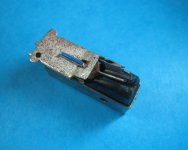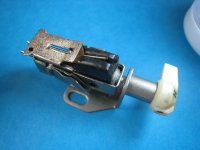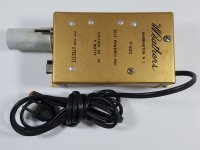Crazy as this sounds, I'm actually tempted to try it because it should be inexpensive and if executed properly, could produce a workable cartridge! Create an Electret Phono Cartridge by coupling a stylus to a pair of 45/45 degree mounted PanasonicWM-61A back electret mic capsules' diaphragms!



Not so crazy. Been done of sorts in the early days of amplified phonographs. Needle hooked to a capacitive diaphram that would change frequency of an FM oscillator. Signal actually broadcast down arm to small receiver circuit then out amplifier.
Doc
Doc
Good luck! Back in the late '70s/early '80s, a company called Microacoustics made a splash with electret cartridges. I had one and was unimpressed, but implementation aside, the idea was intriguing.
Moving mass is your enemy, so things like glue and linkages will be troublesome...
could be intriguing...
_-_-bear
could be intriguing...
_-_-bear
Absolutely!
Absolutely! That's what discourages me from attempting. The tempting thought is that a successful Electret Cartridge could produce 100mv or better into 2.2K with a frequency response virtually immune to effects of electrical loading and immunity to magnetic interference!
Moving mass is your enemy, so things like glue and linkages will be troublesome...
could be intriguing...
_-_-bear
Absolutely! That's what discourages me from attempting. The tempting thought is that a successful Electret Cartridge could produce 100mv or better into 2.2K with a frequency response virtually immune to effects of electrical loading and immunity to magnetic interference!
> a successful Electret Cartridge could produce 100mv or better into 2.2K with a frequency response virtually immune to effects of electrical loading
True, only because it has a preamp IN it.
You could use SMD to build a gain of 10 preamp with 1 ohm output light enough to hang behind your regular cartridge. Yes, with more cleverness you could feed power down the existing leads.
As for adding mass (arm, linkage) to the microphone: it now resonates around 13KHz. Add mass and you could be down to AM quality bandwidth. OTOH, over the range from zero to the top resonance this mechanism would not need the "RIAA curve" as usually drawn with a steep slope. The natural EQ would be flat. For historic reasons you's need 6db rise from 500-2KHz (plus the 50Hz cut).
The diaphragm is VERY stiff, much stiffer than I think you want riding in your precious grooves. Yes, ceramic transducers are stiff, yet a few (a VERY few) were compliant enough for good record wear.
True, only because it has a preamp IN it.
You could use SMD to build a gain of 10 preamp with 1 ohm output light enough to hang behind your regular cartridge. Yes, with more cleverness you could feed power down the existing leads.
As for adding mass (arm, linkage) to the microphone: it now resonates around 13KHz. Add mass and you could be down to AM quality bandwidth. OTOH, over the range from zero to the top resonance this mechanism would not need the "RIAA curve" as usually drawn with a steep slope. The natural EQ would be flat. For historic reasons you's need 6db rise from 500-2KHz (plus the 50Hz cut).
The diaphragm is VERY stiff, much stiffer than I think you want riding in your precious grooves. Yes, ceramic transducers are stiff, yet a few (a VERY few) were compliant enough for good record wear.
Just randomly had this idea and Googled it to find this thread!
Could it work like an electrostatic speaker, where a grounded needle moves inside an electrostatic field and the capacitance change on the stators gives the signal?
Could it work like an electrostatic speaker, where a grounded needle moves inside an electrostatic field and the capacitance change on the stators gives the signal?
It works for microphones (or speakers) because air-coupling demands a "large" area, which also gives large capacitance and thus good output.
A phono needle does not need any real area at all. Adding area adds mass which is bad.
I'm sure it can "work". Can it work as good as a $49 MM cart?
A phono needle does not need any real area at all. Adding area adds mass which is bad.
I'm sure it can "work". Can it work as good as a $49 MM cart?
Look at the old Panasonic strain gauge cartridges for something that actually made it to market and worked reasonably well.
Could it work like an electrostatic speaker, where a grounded needle moves inside an electrostatic field and the capacitance change on the stators gives the signal?
Not exactly the same idea but Weathers marketed a cartridge in the early 60's in which the stylus formed one plate of a capacitor that modulated the frequency of an oscillator. The stylus and circuit operated as an FM generator. The FM signal is then demodulated to produce audio output. Of course at that time this was only mono, not stereo. I have one of these on my bucket list to restore into operating condition. A nice feature of the design is that the moving mass of the stylus is just the stylus tip and cantilever, no magnet or iron or copper coil to add moving mass. It will be interesting to see how it sounds.
Ray K
Attachments
- Home
- Source & Line
- Analogue Source
- Electret Phono Cartridge?



